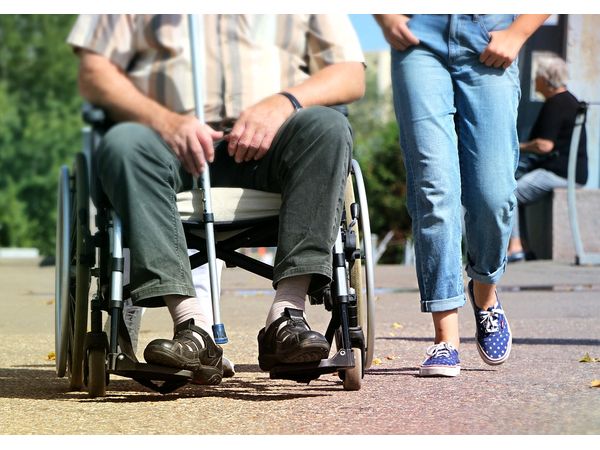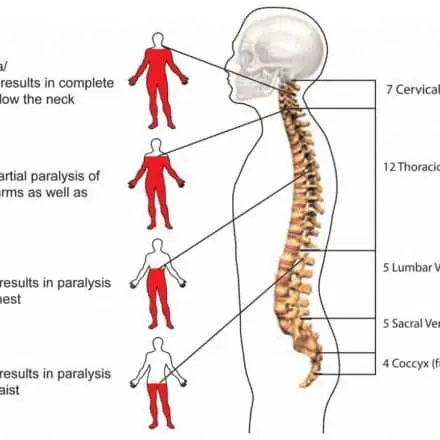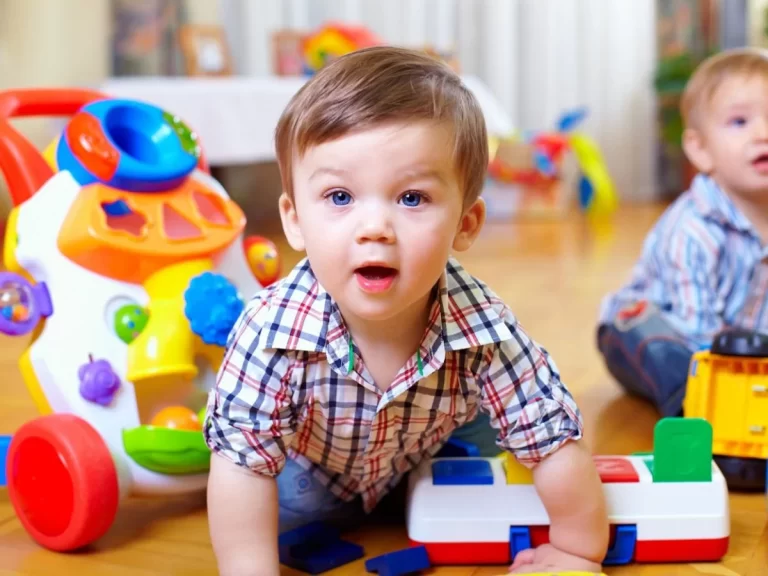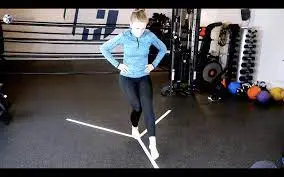Spinal Cord Injury
Table of Contents
What is spinal cord injury?
A spinal cord injury(SCI) is an injury to any part of the spinal cord or nerves at the end of the spinal canal (cauda equina). It often causes permanent changes in motor, sensory and other body functions below the level of the injury.
Many scientists are researching it, which will someday repair spinal cord injuries possible. Research studies are ongoing around the whole world. In the meantime, treatments and rehabilitation allow many people with spinal cord injuries to do work independently and with mobility.
A spinal cord injury (SCI) is an injury to the spinal cord that causes temporary or permanent changes in its function.
Causes:
Causes of spinal cord injuries include:
- Motor vehicle accidents. Commonly seen in young adults
- Falls. Seen in the old age group
- Gunshot wounds.A violent attack
- Sports injuries. Commonly all sports injuries shallow water dives are the most
- Surgical complications.
- Traumatic occurs through a sudden blow to the spine, Gunshot, or knife wound
- A nontraumatic spinal cord injury can be caused by arthritis, cancer, inflammation, infections, or disk degeneration due to repeated work of the spine.
Whether the cause is traumatic or nontraumatic, the damage to the spinal cord and nerve fibers passing from the injured area may be affected and can impair the function of all the muscles acting in that area and nerves below the injury site.
A chest or lower back (thoracic or lumbar level) injury can affect the torso, lower limb, bowel and bladder control, and sexual function. A neck (cervical) injury affects the whole body below the neck in addition to affecting movements of your arms and, possibly, breathing also affected.
Classification:
Spinal cord injury is classified as follows:
- Traumatic
- Non-traumatic
Can be classified into three types based on the cause of injury:
Mechanical forces, Poisonous, and Ischemic (from lack of blood flow).
The damage can also be divided into two ways:
Primary and Secondary injury:
- Primary injury: the cell death that occurs immediately in the original injury, and biochemical cascades that are initiated by the initial insult and cause further tissue damage.
- Secondary injury: These secondary injury pathways include the ischemic cascade, inflammation, swelling, cell suicide, and neurotransmitter imbalances. They can take place in minutes or weeks following the injury.
At each level of the spinal column in spinal vertebrae, spinal nerves branch off from both sides of the spinal cord and exit between a pair of vertebrae, to supply a specific part of the body.
The area of skin supplied by a specific spinal nerve is called a dermatome, and the group of muscles supplied by a single spinal nerve is called a myotome.
The part of the spinal cord that was disrupted corresponds to the spinal nerves at that level and below.
Injuries can be:
- Cervical 1–8 (C1–C8)
- Thoracic 1–12 (T1–T12)
- Lumbar 1–5 (L1–L5)
- Sacral (S1–S5).

Complete: Injury at the lowest level in which all feeling (sensory) and all ability to control movement (motor function) are lost below the spinal cord injury, your injury is called complete.
Incomplete: If the patient has some motor or sensory function below the affected or injured area, the injury is called incomplete.
Paraplegia: Paralysis occurs when the part of the trunk, pelvic organ, and legs are affected by spinal cord damage (in thoracic, lumbar, or sacral injuries).
Tetraplegia: Paralysis occurs when all four limbs are affected due to damage to the cervical level. Arms, hands, trunks, legs, and pelvic organs are all affected.
Signs and Symptoms:
Spinal cord injuries can cause more than one of the following signs and symptoms:
- Loss of mobility
- Loss of or altered sensation, unable to feel heat, cold, and touch
- Loss of bowel or bladder control
- Exaggerated reflex activities or spasms
- Changes in sexual function and fertility
- Pain or an intense numbness sensation caused by damage to the nerve fibers in your spinal cord
- Difficulty in breathing, coughing, or clearing secretions from your lungs
Emergency signs and symptoms:
- Symptoms seen after an accident occurs are
- Extreme back pain or compression in the neck, head, or back
- Weakness or incoordination or paralysis in any part of your body
- Numbness, tingling, paraesthesia, or loss of sensation in hands, fingers, feet, or toes
- Loss of bladder or bowel control
- Difficulty with balance and walking
- Impaired breathing after injury
- An odd position of the neck and back
- Weakness in the arms and or legs.
- Decreased sensation in the hands or legs.
- Severe pain or pressure in the upper part (neck) or lower part (back).
- Unusual lumps along the spine.
- Difficulty breathing.
CERVICAL (NECK) INJURIES
When spinal cord injuries occur in the neck area, it affects the arms, legs, and middle of the body. The symptoms:
It may occur on one (hemiplegia) or both(quadriplegia) sides of the body
Can occur severe breathing problems from paralysis of the breathing muscles if the injury is high up in the neck
THORACIC (CHEST LEVEL) INJURIES
When spinal injuries occur at the chest level, symptoms can affect the legs. Injuries to the cervical or high thoracic spinal cord may have symptoms such as:
- Blood pressure problems (maybe too high or low)
- Abnormal sweating (more)
- Trouble maintaining normal temperature
LUMBAR OR SACRAL (LOWER BACK) INJURIES
When spinal injuries are at the lower back level at the lumbar spine, symptoms may affect one or both legs. Muscles that control the bowels and bladder functions may also be affected. Spine injuries can damage the spinal cord if they are at the upper part of the lumbar spine or the lumbar and sacral nerve roots (cauda equina) if they are at the lower lumbar spine.
Complications:
The following are possible complications of SCI:
- Blood pressure changes that may be extreme (autonomic hyperreflexia)
- Increased risk of injury to numb areas of the body due to the loss of sensation
- Increased risk for urinary tract infections
- May occur Long-term kidney disease
- Loss of bladder and bowel control
- Loss of sexual function
- Paralysis of limbs (paraplegia(two limbs), quadriplegia(all four limbs))
- Paralysis of breathing muscles (quadriplegia)
- Problems due to unable to move, such as deep vein thrombosis (DVT), lung infections, pressure sores, and muscle stiffness
- Spinal Shock
- Depression
Diagnosis:
In acute or chronic spinal cord injury, Imaging technology is an important part of the diagnostic process. SCI can be detected
using different types of imaging which depend on the type of underlying pathology.
Tests that may be ordered include:
- CT scan or MRI of the spine – Neurological tissue and vascular injuries detected
- Myelogram (spine x-ray taken after injecting dye)
- Spine x-ray for any vertebrae injury
- Electromyography (EMG)
- Nerve conduction studies (NCS) for nerve
- Pulmonary function test
- Bladder function test
Treatment:
Non-Surgical Treatments(Medical treatment)
Patients with SCI will generally be admitted to an intensive care unit (ICU). For any injuries of the cervical spine, traction may be used to help bring the spine into proper alignment. Standard ICU care, which includes maintaining stable blood pressure(BP), monitoring cardiovascular function(heart rate, pulse), ensuring adequate ventilation(oxygen) and lung function, and preventing and treating infection and other complications, is important so that patients can achieve the best possible result.
Immobilization: helps to stabilize the spine. The doctor might need traction to stabilize or align the spine. Braces such as soft neck collars and others.
Medications: Methylprednisolone (Solu-Medrol) medicine is given through a vein in the arm (IV) and has been used as a treatment option for an acute SCI in the past. But research has shown that there are possible potential side effects of medications such as blood clots and pneumonia, from using this medication outweigh the benefits.
Due to this, this medicine is no longer recommended for routine use after a spinal cord injury.
Surgery:
Occasionally, if the spinal cord appears to be compressed by a herniated disc, blood clot, or another lesion in the spine area then immediate surgery is needed. This is most commonly done for patients with an incomplete Spinal cord injury or with progressive neurological damage. Even if surgery is not able to reverse damage to the spinal cord, surgery may be useful to stabilize the spine to prevent future pain or deformity.
Physiotherapy treatment:
Spinal cord injury is treated with physiotherapy treatment well.
Physiotherapy for a person with an injured spinal cord should be started as soon as possible after injury. People who have suffered from a spinal cord injury can get benefit from a neurological physiotherapist. A spinal cord injury will have a life-changing impact on patients and their relatives.
Patient with damage to their spinal cord faces considerable challenges throughout their life. Physiotherapy treatment would support and guide you through your treatment working closely with your partners, family, and carers. Physiotherapy treatment will depend on the level of injury and severity of the spinal cord damage you have received.
ACUTE AND SUBACUTE REHABILITATION

- Passive exercises to reduce contractures
- Positioning of joints with sandbags and orthosis
- ROM exercise at least once or 2-3 times a day to prevent contracture
- Stretching exercise in flaccid muscles. later it is converted into spasticity
- Isometric, active, or active-assisted trunk exercise
- breathing exercise
- Strengthening exercises using crutches, swimming, and electric cycle in the acute phase and then for independent transfer,
- Electric stimulation for strengthening
- Corset for fixation and supporting the spine
- wheelchair, walkers, and crutches used for bed transferring
- Splints and orthosis for functional ambulation
CHRONIC REHABILITATION
- The main goal is independent mobilization for both complete and incomplete paraplegic patients with spinal cord injuries.
- All exercises were done in acute and subacute phases if needed
- Walkers, crutches, and orthoses are important aids to provide chronic stage ambulation.
- The manual and battery-operated wheelchairs are also useful
- Occupational therapy to plan the occupational activity after some recovery.
Physiotherapy for a complete spinal cord injury
Physiotherapy for people with a complete SCI would concentrate on maintaining tissue capability increasing muscle strength and maximizing potential and promoting independence. Treatment will focus on:
- Increasing muscle strength above the level of injury to decrease muscle weakness
- Maintaining muscle and tissue length.
- Maintaining a range of movement below the level of injury
- Muscle stretching below the injury level helps to lengthen the tight muscles and reduce stiffness
- Regular standing activities to weight bear and improve the function of internal organs (Sit-to-stand and stand-to-sit activities)
- Exercises to improve patient balance and confidence
-Wall standing - Teaching wheelchair activities which include pushing and turning the chair, operating the brakes, and removing the footplates and armrest
- Breathing control and assisted coughing if appropriate to maintain a clear chest by percussion or breathing exercise
- Teaching transfers activities such as (getting in and out of a wheelchair, bed, car, shower/bath and onto and off a toilet) to improve safety and promote independence
-The wheelchair allows mobility, protects skin integrity,, and maintains normal posture
manual and battery-assisted wheelchair - Advice to use orthotic devices
- Teach different positioning to help posture and prevent pressures sores
-Positioning with the help of sandbags, pillows, plaster splints, orthosis - Improving safety
- Increasing energy levels
- Reducing pain and muscle spasms
- Hydrotherapy treatment
- Bed mobility

C5-C6 and lower level SCI have the ability to attain 5 motor skills;
- rolling (using momentum)
- mobilizing from supine to long-sitting
- unsupported sitting (short & long sitting)
- lifting vertically
- transfers
Physiotherapy for an incomplete spinal cord injury
People with an incomplete SCI present in different ways depending on the severity of the injury. Each person, therefore, needs individual treatment. Physiotherapy treatment would concentrate on rehabilitation and returning the individual to their previous (normal) physical level as much as possible. Treatment will improve functional abilities and work on:
- Exercise to strengthen weak muscles
- Reducing shortness by stretching muscles that have become stiff
- Promoting normal and easy movement
- Increasing control of the movement of the arms, legs, and trunk
- Promoting activities of daily living(ADL)
- Exercises to improve balance at rest or while walking
- Reduce anxiety and help in regaining confidence
- Increase ability to transfer including rolling/moving in bed/sitting/stand
- Exercise to increase stamina and reduce fatigue
- Mobilization exercises to improve circulation and range of movement(ROM)
- Advice on effective positioning to increase comfort
- Advice on orthotic devices and walking aids.
- Hydrotherapy treatment.
- Promoting independence
- Improving the quality of life by functioning and independent as possible
A person with spinal cord injury will have different difficulties depending on the level of the lesion. The physiotherapist will help maximize potential by setting individualized short and long-term goals of treatment. Physiotherapy treatment sessions with specialized physiotherapists are effective and enjoyable leading through a perfect program.
Summary:
There are recently no ways to treat paraplegia and tetraplegia. Therefore, people with tetraplegia need lifetime care.
However, by using various treatments and management techniques, some people may be able to achieve half or full control over the affected extremity.
In many cases, people with SCI would need lifetime help with most daily activities, such as eating, clothing, dressing, and using the bathroom. They are generally unable to live life independently.
Neurotherapist may help patients with the psychological impacts of tetraplegia. Ongoing physical therapy and medication may be necessary to help a patient deal with other difficulties that occur over.
People with SCI might experience difficulties over time. They generally need daily care and treatment. It is not curable, but treatment may help people regain or achieve half or complete control over the affected areas and extremities.
FAQ:
What happens if your spinal cord is damaged?
An SCI can cause one or more symptoms including Numbness, tingling, or a loss of changes in sensation in the hands and feet. Paralysis may happen suddenly or develop after a time as swelling and bleeding affect the spinal cord. Pain or pressure in the head, neck, hands, legs, or back.
What is the type of spinal cord injuries?
There are four types of spinal cord injury based on a different level:
cervical injury, thoracic injury, lumbar injury, and sacral injury.What are the five signs of spinal cord injury?
Extreme back pain or compression in the neck, head, or back
Weakness or incoordination or paralysis in any part of your body
Numbness, tingling, or loss of sensation in your hands, fingers, feet, or toes
Loss of bladder or bowel control
Difficulty with balance and walkingWhat organs are affected by spinal cord injury?
A lower spinal cord injury, in the lumbar vertebrae, may affect nerves and muscles controlling the bladder, bowel, legs, and sexual function. Quadriplegia or tetraplegia is a loss of function in the arms and legs. Paraplegia is a loss of sensation and function in the legs and lower body.
What are the main causes of spinal cord injury?
The main causes of spinal cord injury are:
Road traffic crashes
Falls
Violence (any attack).
A traumatic spinal cord injury is due to work or sports-related injuries.







23 Comments